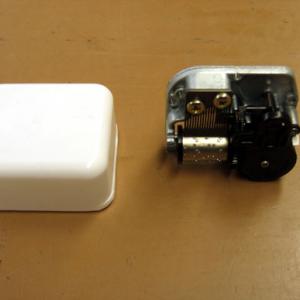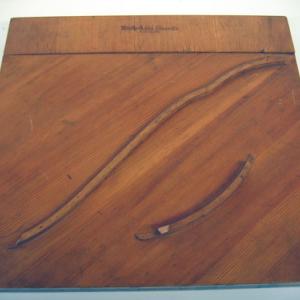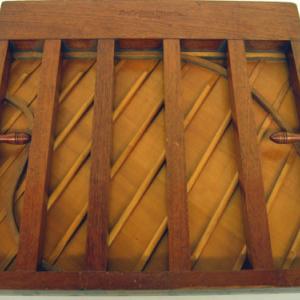College of Liberal Arts & Sciences
3B30.70 - Soundboard
Take the plastic box off the music box element. Wind up the element and hold it in the air while it is playing. The sound should be just barely audible. Attach the plastic box to the element, or touch the element to a table top or tuning fork box. The sound become very audible with the addition of the chosen sound board.
The front and back of a miniature piano sound board are shown with this demo. Tapping on various places on the sound board will reveal those spots with good resonance.
- Bogdan F. Bogacz, Antoni T. Pedziwiatr, "The Sound Field Around a Tuning Fork and the Role of a Resonance Box", TPT, Vol. 53, # 2, Feb. 2015, p. 97.
- George M. Hopkins, "Vibrating Rods", Experimental Science, p. 119.
- Jodi and Roy McCullough, "Sound with a Music Box", The Role of Toys in Teaching Physics, p. 4.136.
- Charles Vivian, "Table-Top Indian", Science Experiments & Amusements For Children, p. 89.
- Martin Gardner, "The Ghostly Glass", Science Tricks, p. 62
- Martin Gardner, "Musical Fork", Entertaining Science Experiments with Everyday Objects, p. 123.
- Vicki Cobb and Kathy Darling, "Hearing Aid", Bet You Can!, p. 51.
- "The Science of Sound", The Boy Scientist, p. 177.
- "Music Box Mechanism", P7-7330, Arbor Scientific, 2004.
Disclaimer: These demonstrations are provided only for illustrative use by persons affiliated with The University of Iowa and only under the direction of a trained instructor or physicist. The University of Iowa is not responsible for demonstrations performed by those using their own equipment or who choose to use this reference material for their own purpose. The demonstrations included here are within the public domain and can be found in materials contained in libraries, bookstores, and through electronic sources. Performing all or any portion of any of these demonstrations, with or without revisions not depicted here entails inherent risks. These risks include, without limitation, bodily injury (and possibly death), including risks to health that may be temporary or permanent and that may exacerbate a pre-existing medical condition; and property loss or damage. Anyone performing any part of these demonstrations, even with revisions, knowingly and voluntarily assumes all risks associated with them.



